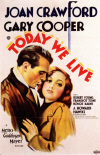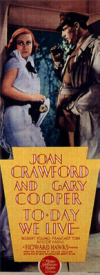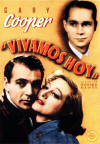
 Diana Boyce-Smith (Joan Crawford), a young English playgirl during World War
I, is having an affair with Claude (Robert Young), who serves as a British
naval officer with Diana's brother Ronnie (Franchot Tone). Diana
thinks she is enamored of Claude, but changes her mind when True Love comes
along in the person of American aviator Bogard (Gary
Cooper). But Bogard goes off on a flying mission and is
reported killed. Whereupon the heartbroken but still resilient Diana
resumes her relationship with Claude, without benefit of clergy.
Diana Boyce-Smith (Joan Crawford), a young English playgirl during World War
I, is having an affair with Claude (Robert Young), who serves as a British
naval officer with Diana's brother Ronnie (Franchot Tone). Diana
thinks she is enamored of Claude, but changes her mind when True Love comes
along in the person of American aviator Bogard (Gary
Cooper). But Bogard goes off on a flying mission and is
reported killed. Whereupon the heartbroken but still resilient Diana
resumes her relationship with Claude, without benefit of clergy.
Her chief confidant is her brother Ronnie, but he tends to side with Claude
when inevitable difficulties arise between Diana and Claude, for Ronnie
feels that Diana is not being completely honest and fair with Claude.
Then Bogard, who had been thought dead, turns up alive and well.
Bogard, Claude and Ronnie are thrown together and begin a friendly but
barbed sea-versus-air rivalry. Scoffing at the Navy, Bogard takes
Claude and Ronnie for a daredevil sky-ride. When they return safely,
Ronnie challenges Bogard to accompany him to sea on Ronnie's motor launch,
which is equipped with a single torpedo. After they have seen some
stiff ocean action, Bogard has been duly convinced that there is just as
much excitement on the sea as in the air.
Claude is blinded in action, and as he and Ronnie know that Diana deeply
loves Bogard, they decide that her happiness should not be jeopardized a
second time when they hear that Bogard has offered to sacrifice his life on
a suicide mission that involves sinking an enemy ship. So Ronnie
and the blind Claude go out to sea in their launch and sink the vessel
before Bogard has had a chance to attack it from the air. They lose
their lives in the process. Bogard returns unharmed to Diana, and
though relieved to be reunited, their joy is tempered by the knowledge of
the frightful sacrifice of loved ones that made it possible.
 What was said about
Today We Live:
What was said about
Today We Live:
New York Times (Mordaunt Hall)
Miss Crawford, although she never impresses one as being English, gives a
steadfast and earnest portrayal...(The Picture) is vague and cumbersome...As
a drama of the war it is not precisely convincing, for coincidences play an
important part in its arrangement. It is also anachronistic,
particularly as regards the costumes worn by
Joan Crawford.
New York Herald Tribune (Richard Watts, Jr.)
Visually, Today We Live is handsome, striking and genuinely dramatic,
and that is not merely because Miss Crawford is photographed so beautifully.
The scenes of aerial warfare are enormously effective, but such scenes have
been portrayed so frequently that they have become the commonplaces of the
photoplay...Miss Crawford is properly effective in her role even if she
doesn't seem like someone called Boyce-Smith.
Although William Faulkner is billed as the author of Today We Live,
the picture is no devastating survey of the degeneracy of the New South,
filled with murderous neurotics and pathological passions. Instead, it
is a lugubrious romance of the war, replete with clipped speeches, heroic
sacrifices, self-effacing nobility and many cries of "stout fellow!"
As a matter of fact, it is only when one of the characters begins to play
quaintly with a cockroach that you see any particular traces of the Faulkner
influence at all. For the rest of the time, the work seems more akin
to Journey's End than to Sanctuary or Light in August
and devotes most of its efforts to permitting Robert Young and
Franchot Tone
to destroy themselves gallantly so that
Gary Cooper may henceforth
live happily with Miss
Joan Crawford. It was my suspicion yesterday
that their sacrifice was too great.
